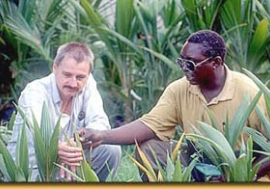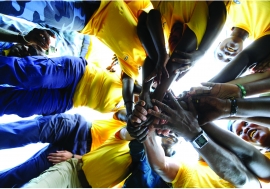To save the lives of mothers, infants
To save the lives of mothers, infants
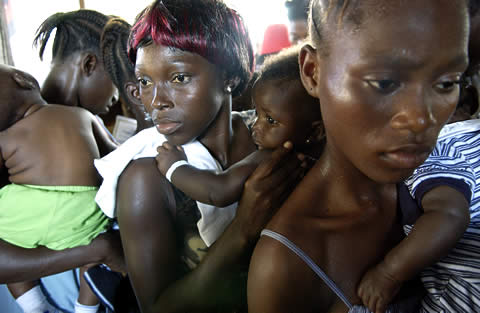 Half of all women worldwide who die of complications from pregnancy are in sub-Saharan Africa, where 160 of every 1,000 children born also die before the age of five.
Half of all women worldwide who die of complications from pregnancy are in sub-Saharan Africa, where 160 of every 1,000 children born also die before the age of five.In an otherwise grim outlook for Africa’s hopes of achieving the Millennium Development Goals (MDGs) there is some good news. Rwanda is very likely to meet the MDG targets for child and maternal mortality, and will possibly be one of few countries in Africa to surpass them by the 2015 deadline. That is all the more remarkable given Rwanda’s painful history of genocide, which left the economy of that small nation in tatters and its society in complete disarray.
Théophile Ndabereye, a worker at the Mayange Health Centre, is pleased by some major changes at his clinic, where new equipment and more staff contribute to safe and hygienic births. “We used to only have three trained nurses and most moms were giving birth at home. We now have eighteen,” Mr. Ndabereye explained, according to a case study by the UK’s aid agency, the Department for International Development (DfID). As a result, most of the mothers in the area now give birth at the health centre. Life expectancy for the babies has improved as well. Mothers stay for three days after delivery. “Even if mothers are in a hurry to go back to their home after they give birth, we show and explain to them why it is very important that they stay with us for three days,” he said. “And they understand and they stay, for the sake of their new babies.”
The women and their families in Mayange can trace many of these changes to the government’s health insurance programme, Mutuelles de santé, which is run by community representatives and local health providers. Access to the programme increased from 7 per cent to 85 per cent of the population between 2002 and 2008. Those enrolled pay an annual premium equivalent to US$2. Women who attend four appointments during a pregnancy deliver at no cost.
The initial results are impressive. Child mortality has decreased by over 30 per cent since 2005 and maternal mortality declined by 25 per cent in the years up to 2005. A number of other areas of progress contributed to these results:
- an increase in assisted-birth deliveries from 39 per cent to 52 per cent between 2005 and 2007
- a rise in the use of family planning methods from 10 to 27 per cent between 2005 and 2007
- a decline in the fertility rate from 6.1 to 5.5 children per woman
- achievement of immunization rates of 95 per cent by 2008
- an increase in the use of insecticide-treated bed nets from 4 to 67 per cent of the population between 2004 and 2007 and
- a decrease in the HIV prevalence rate to 3 per cent.
Marie Rose Mukankudinye, one of Mayange’s mothers who delivered her baby safely, could not be more satisfied. “I want to encourage as many people as possible to visit the health centre,” she said, “Healthy children can go much further in life.”
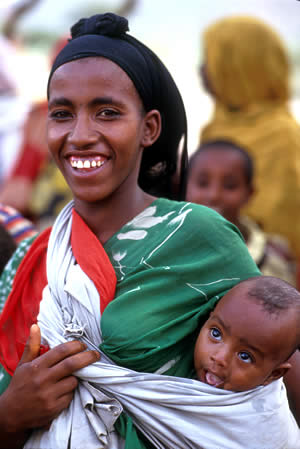 In Ethiopia, Rwanda and a few other African countries, improvements in care for expectant mothers and newborns are allowing many more to survive and remain healthy.
In Ethiopia, Rwanda and a few other African countries, improvements in care for expectant mothers and newborns are allowing many more to survive and remain healthy.Rwanda’s achievements are all the more welcome on a continent where overall progress towards these goals has been barely perceptible. They demonstrate what is possible when political will, innovative policy and sustained donor support work in concert.
Alarming mortality rates
Global maternal mortality statistics are alarming, and particularly so in Africa. Of the 536,000 women worldwide who die each year from complications of pregnancy or delivery, 99 per cent are in developing countries. Of those, half are in sub-Saharan Africa.
The deaths are the tip of the iceberg. For every one woman who dies, 20 more suffer injury, infection or lasting disabilities. For many, this brings an end to their mothering and caring roles, and can lead to removal from their families in disgrace. For example, fistula, a condition unknown in the industrialized world that can result from prolonged and obstructed labour and leaves survivors incontinent, frequently isolates women from their families and communities.
The statistics for child mortality are equally alarming. Of the nearly 10 million children under the age of five who die worldwide each year, 99 per cent are from developing countries. Of those, 4 million die within the first 28 days of life, and half of those within the first 24 hours. In sub-Saharan Africa 160 children die for every 1,000 live births. In the UK, by comparison, the figure is six per 1,000.
For children whose mothers die, the cost can be high. Besides the emotional loss, they are robbed of the very person who would be the one most likely to maintain their health and care for them when they are sick. Studies by the UN Children’s Fund (UNICEF) show that children are more likely to die by the age of two if their mother died within the first six weeks of their life.
Worldwide, child mortality has steadily declined over the past two decades. But there are indications that progress is slowing, and in some areas of sub-Saharan Africa an upward trend is becoming evident. Maternal mortality is declining far too slowly to come near to meeting the targets. In sub-Saharan Africa the annual rate of reduction is 0.1 per cent, far too slow to reach the goal of a 75 per cent reduction from 1990 to 2015.
It is widely acknowledged that the vast majority of these deaths and disabilities are preventable.
Innovative responses
The urgency of the situation has not gone unrecognized. One recent effort to boost progress towards the MDGs on child and maternal mortality has been led by UK Prime Minister Gordon Brown and World Bank President Robert Zoellick. A high-level meeting at the UN General Assembly on 23 September 2009 launched the report of the Taskforce on Innovative Financing for Health Systems, which the two officials had initiated with other world leaders a year earlier. The meeting called for stronger, better-financed health systems and better access to health services for women and children.
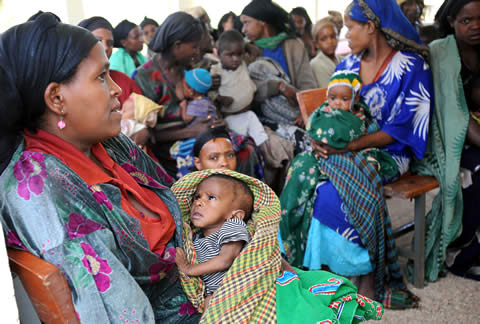 Health clinic in Dosha, Ethiopia: Within just three years, the country nearly doubled its number of health workers, and maternal mortality rates declined dramatically.
Health clinic in Dosha, Ethiopia: Within just three years, the country nearly doubled its number of health workers, and maternal mortality rates declined dramatically.“Innovative financing” may be the key, given the state of the global economy, acknowledged Prime Minister Brown. He called on every country in the developed world to “help poorer nations trade their way out of recession and deliver essential health care to the most vulnerable.” Action is urgently needed, he said, since the MDGs are “already well behind schedule.”
Similar concerns about the MDGs were expressed at another high-level meeting held in Addis Ababa, Ethiopia, a month later. It was convened by the UN Population Fund (UNFPA) and the government of the Netherlands to discuss maternal health, identified as making the least progress of all the MDGs. “We know what it would cost to meet our goals,” stated UNFPA Executive Director Thoraya Obaid, “and, sadly, we know the cost of too little action.”
The measures needed to reverse this crisis were spelled out by the “Consensus for Maternal, Newborn and Child Health,” a programme launched at the UN meeting in September and spearheaded by a broad coalition of governments, non-governmental organizations, international health agencies and individuals. The consensus highlights the need for political leadership and community mobilization, with accountability at all levels. It also insists on adequate financial and human resources to ensure:
- effective health systems that deliver high-quality interventions
- the removal of financial barriers to access so that services to women and children are free, and
- skilled and motivated health workers, with the necessary infrastructure, drugs, equipment and regulations.
The projected price tag to achieve this was estimated at $30 bn from 2009 to 2015, with annual costs rising from $2.5 bn to $5.5 bn over the period. The task force on innovative financing identified some $5.3 bn that could be raised through voluntary contributions with the purchase of airline tickets, debt conversions, the expansion of existing immunization financing facilities and other innovative methods.
Women’s status
Some argue that more than political will and increased funding is needed, given the other factors that hamper progress. These include child marriage, lower rates of education for girls and high illiteracy rates for women, lack of access to contraception, female genital mutilation, violence against women, lower nutritional levels for girls and women and the stigma associated with HIV/AIDS and fistula.
Violations of women’s rights have been identified by UNFPA and UNICEF as critical barriers to improved infant and maternal health. These are in turn connected to pervasive poverty and cultural attitudes. Achieving the MDG to promote gender equality and women’s empowerment is therefore intertwined with the goals on maternal and child health.
As UNICEF noted in its 2008 Report Card on Maternal Mortality, “The causes of maternal mortality and morbidity are so clear — as are the means to combat them — that it is difficult to avoid the conclusion they have remained unaddressed for so long due to women’s disadvantageous social, political and economic status in many societies.”
Aminata Touré, chief of the UNFPA’s gender, human rights and culture branch, notes a paradox in the widespread failure to reduce maternal mortality. “In most societies in the world, motherhood is very valued and celebrated,” Ms. Touré told Africa Renewal. “At the same time there is a deficit of attention and seriousness in terms of addressing the question of maternal mortality, so that it is highly unlikely that in many developing countries the goals relating to maternal health will be achieved.”
Openings for progress
Stan Bernstein, a UNFPA senior policy adviser, points out that while the impact of gender inequity cannot be ignored, strong inroads have been made with sufficient political will and appropriate funding. “While there is room for skepticism, there are openings for some real progress. Some degree of skepticism can be constructive,” he told Africa Renewal, “if it identifies bottlenecks and key constraints so that people’s attention can be focused on how to respond to them.”
Mr. Bernstein adds that there are already a number of countries showing how to reverse the figures. “These achievements have been possible because of political will, thoughtful policy decisions and adequate funding.”
Rwanda is one example. Ethiopia is another. Within three years, Ethiopia has nearly doubled its health workforce, providing every village with two trained health extension workers, for a total of 30,000. They are employed full time as salaried civil servants, which represents a move away from the traditional reliance on volunteers. Most of the workers are local young women who have completed high school and are trained intensively for one year. Women who use the services are more likely to trust health workers who are also women.
The results have been tangible. Maternal mortality of 871 per 100,000 in 2000 decreased to 671 by 2005. If this trend is maintained, Ethiopia could reach the MDG goal of reducing maternal mortality by 75 per cent by the target year of 2015. While the under-five mortality rate is decreasing more slowly, the drop from 204 to 119 per 1,000 between 1990 and 2007 is significant.
Other health improvements could also help ensure that the goals are met. For instance, the upturn in the proportion of women using contraceptives from 27 per cent to 58 per cent over the past five years is likely to have an impact on how many children the average woman has. More spacing between births can significantly reduce both maternal and childhood mortality. So can the increase in the share of pregnant women receiving prenatal care from 50 per cent in 2005 to 60 per cent in 2009, and the rise in postnatal care from 16 per cent to 28 per cent over the same period.
Political leadership
Rwanda and Ethiopia demonstrate that considerable progress is possible when appropriate funds are available and political leaderships act to change policies. Both countries have seen improvements in women’s equality.
Other countries are taking their own initiatives. Burundi is providing free health care to all children under five and to pregnant women. Malawi is extending free health services through government- and church-run hospitals. Sierra Leone is planning to provide free health care to women and children. Ghana will exempt pregnant women, children under 18 and the elderly from health insurance premiums. Liberia is hoping to abolish user fees for health services with the help of donor financing.
For Africa and other parts of the world, the challenges remain daunting, UN Secretary-General Ban Ki-moon noted at the UN meeting in September. “We still have a long way to go to reach the goal of reducing child mortality rates.… And we have a long road to travel to reduce maternal mortality,” he said.
But these goals are achievable, Mr. Ban added. “We know what to do. We know what it takes to save lives. We know how to improve the health of women, babies and children. It is said that a society can be judged by how it treats women and children. Just as no woman should die needlessly in childbirth, no person of conscience should stand by as such senseless deaths continue.”











